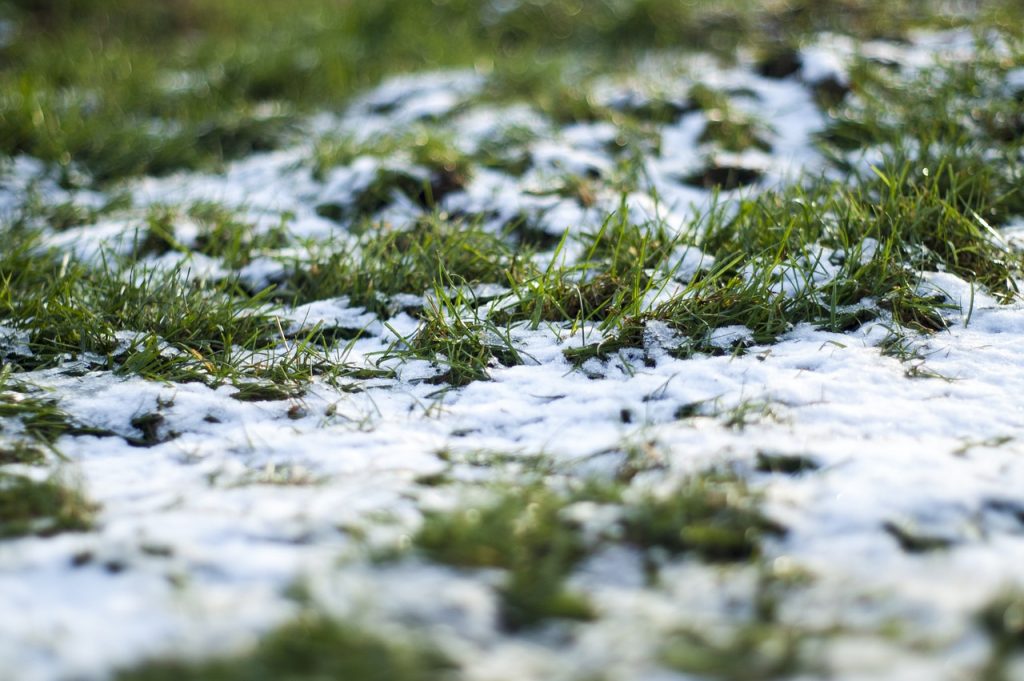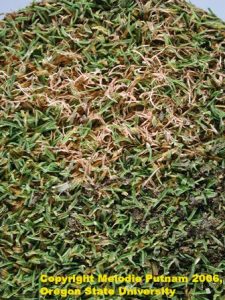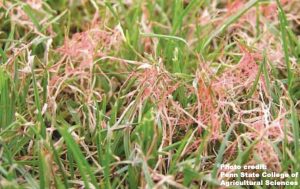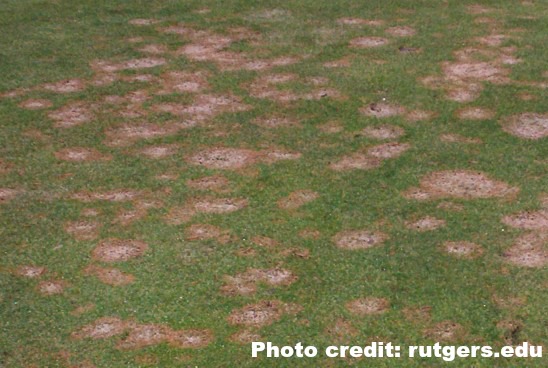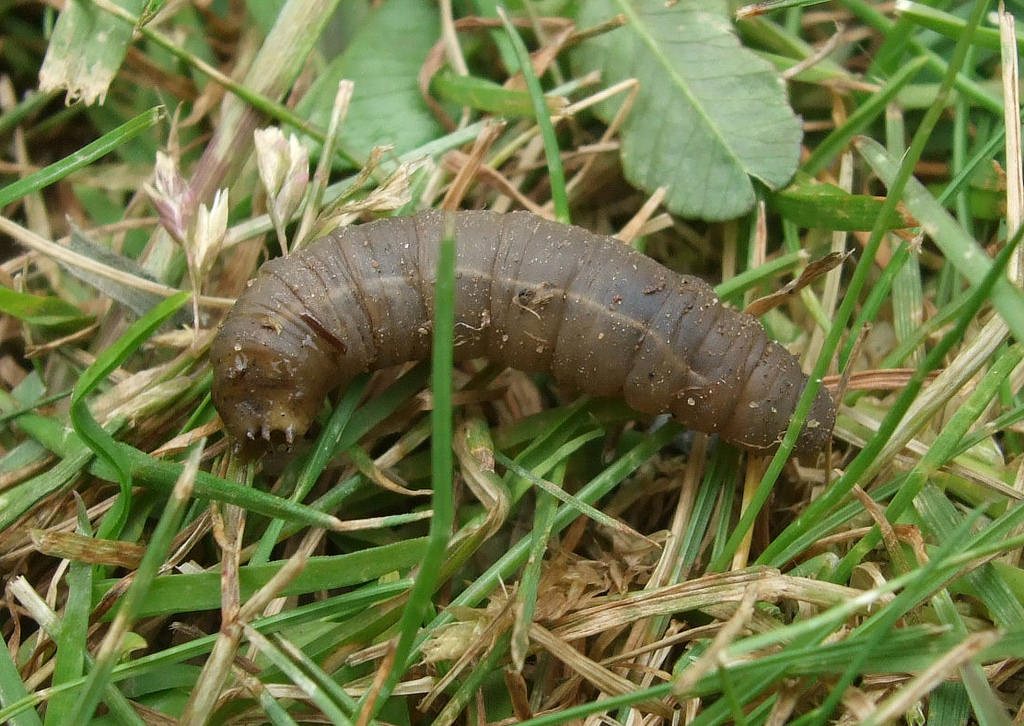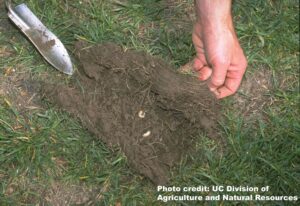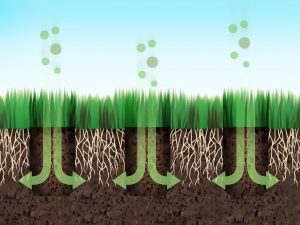In a year when winter has been particularly long, cold, and wet, it’s not unusual to enter spring with a distressed lawn. The high pressure produced by intense winter conditions creates a lot of opportunities for pests and diseases to move in and cause problems.
Here are a few common issues we observe in the Clark County and Portland metro area. If you’re seeing bare patches, brown patches, or circular patches of pink or white, you may be facing one of the following:
Red Thread
Red thread, or Laetisaria fuciformis, is an opportunistic lawn disease. Its name comes from thin red strands this fungus sends out from the tips of infected grass blades. If your lawn and soil isn’t well drained, a wet winter can throw the door wide open for problems due to this infection. Prolonged exposure to moisture is the primary cause of red thread in unhealthy turf.
From a distance, you may notice circular patches of pinkish grass ranging up to 8 inches in diameter. It’s important to take a closer look to see if ‘threads’ are present, though, as there are similar symptoms that result from other kinds of issues.
The good news is that red thread does not destroy grass roots and crowns. There is potential for full recovery if you commit to thorough treatment. The best way to ward off future infections of red thread is by conditioning your soil, providing good drainage, and sticking to a proven, consistent maintenance plan.
Pink Snow Mold
Pink snow mold, as its name implies, is associated with extended snow cover. Like red thread, it’s caused by a fungus, Microdochium nivale. Pink and white foamy fungal spores sit on top of infected grass blades, creating pink circular splotches across the lawn. In a prolonged wet and snowy winter, it can result in severe damage to turf.
The road to recovery begins with skilled thatching and aeration. Committing to best practices for fertilization, drainage, snow management, and pest control is the key to keeping damage from snow mold to a minimum, whatever future winters may bring.
Crane Fly
Crane fly infestations are notorious for their potential to kill an entire lawn. While adult crane flies swoop and fly around the yard, it’s the eggs they lay down that spell serious trouble. Crane fly larvae (also known as ‘leatherjackets’) are 1-inch long and tan or grayish white in color. The hungry larvae wreak havoc on turf as they feast on grass roots and crowns.
Look for patches of damaged grass that may appear to grow together and spread. Peeling back the soil will reveal whether crane fly larvae are to blame. While a healthy lawn can handle a medium population of larvae, a teeming infestation means it’s time to call for help.
The encouraging thing about battling crane fly is the potential for treatment and full recovery. The crew at Frontier Landscaping has generated impressive results for lawn restoration and would be happy to work with you to save your lawn if you’re dealing with an outbreak this year.
Maintaining healthy turfgrass is the #1 way to prevent future pest and disease issues!
Lawn Rescues and Revamps
In the moist Pacific Northwest, especially after a very wet winter, it’s not uncommon to have problems show up if your soil and grass haven’t been regularly maintained for optimal health.
If you’re in need of treatment, the Frontier Landscaping crew is expertly qualified to help you back to a thriving, healthy lawn. The process we have developed through years of local experience consistently produces successful, healthy turf.
Aeration
Aeration is a generic term for exposing soil to the air by removing plugs of soil from the turf. The openings created by aeration help water and nutrients move more easily through the soil.
While it’s common practice to leave soil plugs in a lawn after aeration, the crew at Frontier Landscaping has determined that the most successful lawns are created when we pick up and dispose of the hardened plugs. This additional step allows topdressing to better penetrate the new holes in the soil, enhancing the entire aeration process overall. While it is a greater effort, this step has consistently shown itself to be an effective key to helping sick lawns bounce back quickly and look better than ever.
Additional benefits of aeration:
- Limits fertilizer runoff
- Improves ability to absorb water
- Slows buildup of thatch
- Builds strong root system and layer of topsoil
Frontier Landscaping recommends aeration once each year for all lawns to maintain great health.
Reseeding and Fertilization
Once soil has been aerated, ¼ to 1 inch of rich soil conditioner is applied. This mix works down through the new holes left by aeration and sets the lawn up for improved future drainage.
Why does this matter? Good soil texture promotes healthy turf. In turn, healthy turf is significantly less susceptible to disease.
Once soil has been treated, your lawn will be ready to be reseeded and fertilized. It’s not uncommon to see new grass emerging within a month of completion.
Intense seasons of wet weather can result in significant pest and disease pressure on lawns, especially if the grass isn’t robust and healthy to begin with.
If you find yourself facing ugly bare spots, remember that many issues are treatable if caught in time. Give us a call to learn about treatment options for your lawn. We’ll help you through and are happy to design a custom care plan for the future based on the specific needs of your landscape.


